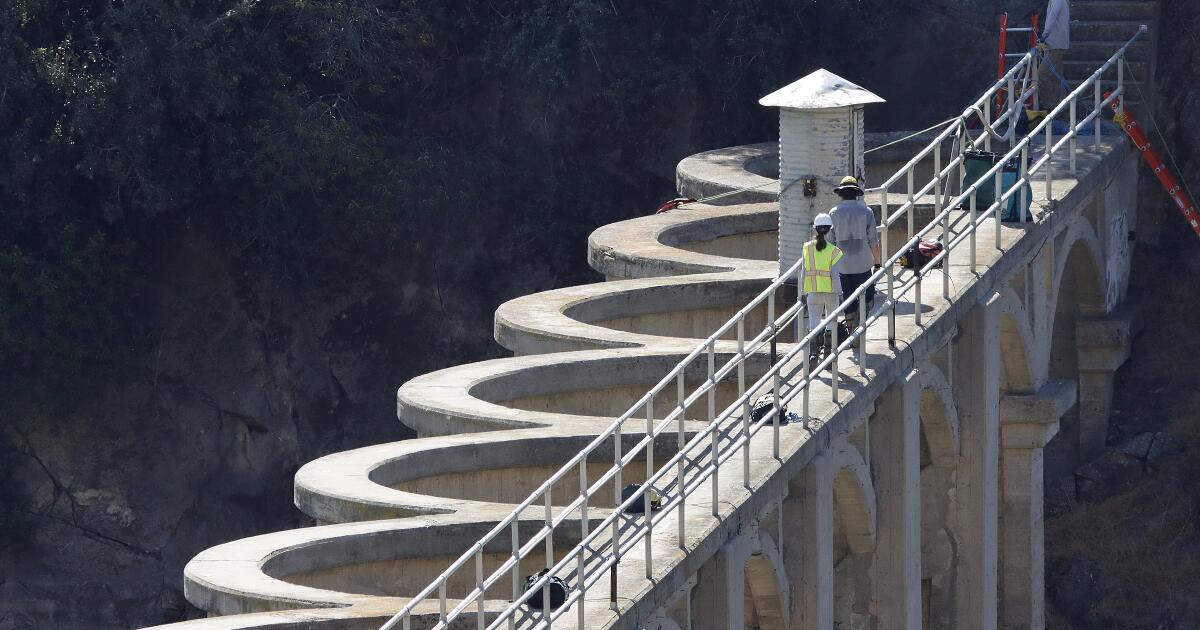
San Diego is accelerating efforts to shore up the city’s aging dams, including moving up construction of the new Lake Hodges Dam from 2031 to 2029 and committing to comprehensively evaluating the eight other city dams by 2028.
The goal is to determine whether a $1 billion estimate of total repair costs is accurate, deciding which dams need the most work and weighing which projects should be prioritized over others.
“We can’t do everything tomorrow, so we need to find a way to strategically plan for the highest priority actions,” Kelly Balo, interim deputy director of the city’s Public Utilities Department, said last week.
Because the dams and the attached reservoirs play a crucial role in storing the city’s drinking water, costs for the renovations and rebuilds will be passed on to the city’s water customers.
The evaluations include assessing the dams for seismic vulnerabilities, structural deficiencies and flood risk — how many people’s lives would be in jeopardy in the event of a partial or complete dam failure.
City officials and consultants have completed 35 of an estimated 120 individual assessments needed to determine the status of each of the nine dams. The city has committed to completing the 80-plus remaining within five years.
When the evaluations are complete, city officials say they will lay out a decades-long plan to shore up every dam that will include cost estimates and specific timelines.
San Diego’s dams are among the oldest in the state. State officials have deemed Hodges “unsatisfactory” and have rated three others as being in “poor” condition — Morena, El Capitan and Lower Otay.
Murray and Barrett got ratings of “fair,” while San Vicente, Miramar and Sutherland were rated “satisfactory.”
Four of the dams are more than 100 years old, and the average age of the city’s dams is 92. By comparison, the average age of the 91,000 dams in the U.S. is 57 years old, while the average age of the 1,476 dams in California is 70.
Because some of the dams have structural problems, city officials have been forced to push out rainwater in controlled releases after rainstorms to reduce reservoirs to safe levels.
Lake Murray was recently added to the list of city dams that must be kept below their maximum volume because of structural concerns, joining Lake Hodges, Lake Morena and El Capitan Reservoir.
The new evaluations will help determine whether those restrictions should remain in place, can be eliminated or must be strengthened further.
Balo said city officials plan to accelerate the design and environmental approvals for the replacement Hodges Dam by tackling tasks simultaneously instead of consecutively.
“We’ve been able to shave a number of years off the schedule, and we are committed to starting construction by the end of calendar year 2029,” she said.
The new dam, a roller-compacted concrete dam, is expected to cost $275 million. It will be built roughly 100 feet downstream from the existing dam.
San Diego’s greater attention to its dams is part of a statewide trend that began after the near failure in 2017 of Sacramento’s Oroville Dam. The local dams that are similar in stucture to Oroville are Hodges, El Capitan, Morena and Lower Otay.
Dam projects recently completed by the city include designing new spillways — the route for excess water to exit the reservoir — for Hodges, Morena and El Capitan.
Ongoing projects include a seismic evaluation at Murray, a stability assessment at Morena and a tunnel assessment at Barrett. And last month, the City Council approved $9 million for short-term repairs at Morena and El Capitan.
The city has been hiring new employees to help assess and renovate the dams. A dam safety team was created in 2020, and an in-house repair crew was staffed this year. Officials say they also expect to hire several consultants in coming years to help with assessments.
Many of San Diego’s the dams are outside city limits.
Lake Morena, near Campo, dates back to 1912. Lower Otay, near Chula Vista, opened in 1916. Lake Hodges opened in 1919. Barrett, near Jamul, opened in 1922. El Capitan, near Lakeside, opened in 1935.
San Vicente, also near Lakeside, opened in 1943. Murray, near La Mesa, opened in 1950. Sutherland, in Ramona, opened in 1954. And Miramar opened in 1960.






